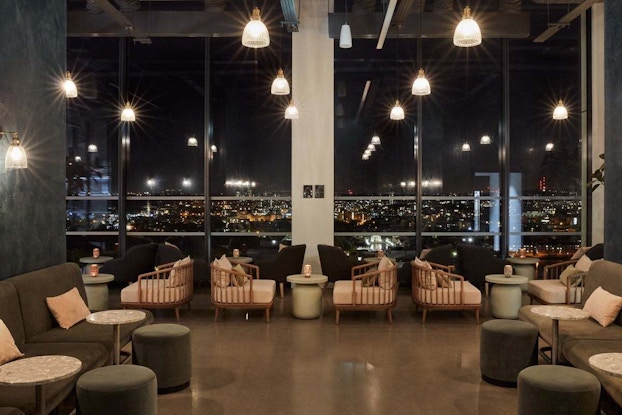
Millennials have been slower to reach traditional life moments like getting married, having children and buying a home, creating a ripple effect felt throughout the consumer economy.
Real estate has seen its fair share of impact, as economic and social circumstances have led to higher concentrations of young people migrating to and staying in big cities, rather than pursuing the stereotypical 20th century path of settling down and moving to a bigger home in the suburbs. Meanwhile, older generations are living longer and healthier lives, leading to an increased need for new and improved senior communities.
Creative co-living concepts have arisen as a result, in what may seem to be a natural dovetailing of the sharing and gig economies. However, in the wake of the We Company’s problematic WeLive concept, it’s worth asking: Is co-living a real, long-term evolution of the way humans live, or just a collection of startups ready to capitalize on a trend?
CO— spoke with Cheryl Young, senior economist at Zillow, for expert insight into the co-living trend and the future of real estate. “I think, culturally, younger people are just more open to these kinds of living situations,” she said. “We're going to see this for a while as people try to navigate how expensive cities are.”
Co-living: what’s old is new again
Co-living looks a lot like the rooming houses that were once common — and now illegal — in many cities. Generally, renters would get a private bedroom but share access to facilities like a bathroom and kitchen, at an affordable rate that made city living accessible to most. Now, however, these communal living spaces come equipped to meet the demands of the 21st century.
“Co-living arrangements and SROs [single room occupancies] both provide housing solutions for individuals who want or need to live near a city center but many not have the means to rent their own place. However, that may be where the similarities end,” Young said. “SROs primarily focus on individuals looking for functional, affordable accommodations, while co-living is a novel real estate concept that reflects an evolution of apartment-style living.”

For younger people, co-living is an opportunity to mitigate the cost of city living without forsaking amenities like laundry or a fitness center. It can also serve as a built-in community, offering events and social spaces to encourage communication in an era when reports of loneliness and depression are at an all-time high. At the other end of the spectrum, co-living can be a solution for aging adults looking to leave behind the responsibility and upkeep of a single-family home, but who can’t afford or are not yet in need of the care of a traditional nursing home.
Some cities are experimenting with co-living-designed affordable housing programs. New York City, for instance, is experimenting with two co-living startups, Common and PadSplit, on different housing projects with the goal of combatting the city’s shortage of affordable apartments.
All told, co-living, Young said, “leans into providing features that offer a lifestyle that appeals to those who want to both live near job centers and amenities, and socialize with their neighbors.”
The gig economy becomes the gig lifestyle
Steep housing costs and changing lifestyles have younger consumers living with roommates longer and looking to other alternative living arrangements. According to a 2019 study by Zillow real estate platform Trulia, for example, the share of married couples in the U.S. living with a non-related roommate has grown almost 40% since 1995, especially in expensive housing markets.
Affordability and availability of housing is only part of the equation. Rules of traditional employment have been redefined by the gig economy, resulting in an estimated 43% of the U.S. workforce working remotely at least some of the time, according to a Gallup report.
Despite co-living’s easy characterization as “dorm rooms for adults,” its low-commitment nature makes a lot of sense for a generation of gig workers. This saves residents the trouble of finding and furnishing their own short-term rental, avoiding the commitment of a traditional lease and roommates. Nationwide and even global networks of properties allow approved members to move between cities as their work or lifestyle requires.
There’s no shortage of new companies angling for the attention of today’s digital nomads, and nearly every major city seems to have at least one large co-living project either recently opened or in the works. Following the We Company’s fumbled WeLive project attempted IPO and high-profile troubles this year, the future of co-living seems to belong to this new crop of millennial-friendly startups.
Co-living and coworking demonstrate the interest in creative, novel ways to reimagine residential and commercial space.Cheryl Young, senior economist, Zillow
Changing trends
Co-living companies are capitalizing on the consumer desire of commitment-free, affordable housing, in optimal areas with attractive amenities. Read on for more of today's changing business trends.
Common, one of the most widespread thus far, offers all-inclusive co-living experiences complete with pre-vetted roommates, fully furnished studio rooms, Wi-Fi, cable television, housekeeping, kitchen supplies, and flex community spaces, catering to a higher-end customer looking to embrace the gig lifestyle without sacrificing service and style. Competitors Ollie and The Collective operate all-inclusive luxury buildings that add amenities like smart home technology, rooftop pools, fitness centers and lounges.
Padsplit, on the other hand, looks more like a home share than an extended stay hotel, and hopes to expand workforce housing for cities’ low-wage workers — while, much like Airbnb, promising to generate extra income for homeowners. The platform, currently just open to the Atlanta area, lets homeowners rent out spare bedrooms but does all the legwork of tenant screening and weekly rent collection.
“Co-living and coworking demonstrate the interest in creative, novel ways to reimagine residential and commercial space,” Young said. “It’s not clear, however, that one has evolved out of the other since shared living and shared work spaces address different sets of demands.”
Imagining the housing market of the future
Price of rent aside, co-living speaks to some of the larger demands driving changes to the real estate industry.
As Generation Z ages into its spending power and begins to make up a larger contingent of homebuyers, access to technology becomes an increasingly key amenity. “They definitely want different things from their home than previous generations,” Young says. “I think a lot of this comes out of some of the technology that's available now. They're much more interested in things like smart home capability.”
They’re not the only ones. According to Zillow data, 40% of millennials find it important to have smart tech in the home. It’s an important differentiator when it comes to senior housing as well, providing resources to support solo living as residents age. Features like smart kitchen appliances that help auto-replenish groceries, or voice-controlled devices that help in an emergency, are some of the tools that independent co-living spaces may be able to deliver to aging residents.

In the conversation around co-living as a solution for the aging population, Young brings up another potential issue for the future of real estate. If many of the older people who might soon choose to relocate to co-living facilities are currently living in single family homes, and millennials continue to move away from traditional home ownership in favor of apartment living in urban job centers, who will move into the soon-to-be-vacant suburban houses?
“The question that really remains to me,” Young says, “[is] whether they’re willing to shift back to these single-family home areas that are really different than what we're seeing in coliving or dense urban areas.” She predicts that there may be a rise in multiuse suburban spaces that bring together communities, offering entertainment, retail, services and municipal functions in a single location.
The scenario begs the question of whether or not the co-living concept will remain unique to metropolitan areas and single renters. More companies may welcome family units and offer kid-friendly perks, or millennial families may move out to the suburbs looking for the all-inclusive experience delivered by Ollie, The Collective and their cohort.
Ultimately, it’s unclear how much millennials will move the needle. “Even though we're seeing young people driving this real estate market,” Young said, “I think it's not really changing the landscape as much as we think it might be. It’s really just a new way to think about the features of a home.
CO— aims to bring you inspiration from leading respected experts. However, before making any business decision, you should consult a professional who can advise you based on your individual situation.
Want to read more? Be sure to follow us on LinkedIn!
CO—is committed to helping you start, run and grow your small business. Learn more about the benefits of small business membership in the U.S. Chamber of Commerce, here.









